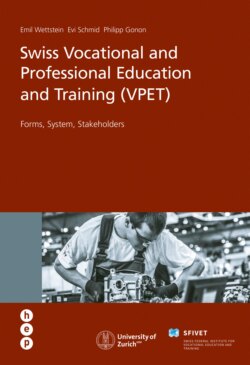Читать книгу Swiss Vocational and Professional Education and Training (VPET) - Philipp Gonon, Emil Wettstein - Страница 8
На сайте Литреса книга снята с продажи.
ОглавлениеPORTRAIT OF NICOLE RENGGLI
Nicole Renggli, 17,
prospective Health Care Assistant, Federal VET Diploma (Fachfrau Gesundheit EFZ), takes part in a branch course
clear
The middle of the three learning locations
Sensing how a patient feels, finding out how work is done in other institutions – prospective health care assistants can experience this in the branch course. Nicole Renggli is one of them.
Mr Traber is 65 years old. He has suffered from chronic polyarthritis for many years, and now he has also had a fall. He has broken his right ankle, two ribs and his right forearm. In Flavia’s enactment, he moans and keeps the staff on their toes: “Can it not go a bit faster, have you ever been in pain!” Enactment? That’s right: we are in the training centre of the Zentralschweizer Interessengemeinschaft Gesundheitsberufe ZIGG (the professional organisation of health care professions of the cantons in central Switzerland) in Alpnach Dorf and are witnessing role playing. Prospective health care assistants are enacting a “postoperative situation” and documenting it with a movie camera.
Scenes like this are part of the didactic repertoire of branch courses (überbetriebliche Kurse, üK) in the health care sector. Here, 70 per cent of the learning time consists of exercises or group projects, the rest is used for silent reading and lectures. The training centre in Alpnach Dorf – a new building in the industrial area – is equipped accordingly: in the classrooms, there are beds behind the desks, a materials store contains around 700 care items. Measuring vital signs, gait training, pressure-relieving positioning – Module 6, with which the learners are currently occupied, offers countless opportunities for practising. Nicole Renggli, one of the learners, thinks this is great. First of all, the exercises offer the opportunity to carefully try out procedures and discuss questions. And secondly, in the role of the patient, the students learn how care work feels. In the case of Mr Traber, aka Flavia, the change of perspective had a downright cathartic effect. “You were really nasty,” said one of her colleagues after the role play. Flavia replied: “My patients are too sometimes.”
The three-year training of Nicole Renggli includes 34 branch course days which are divided into 12 modules. Their contents are coordinated with events at the two other learning locations. Ernst Schäfer, head of education and training in the training centre, explains: “If possible, new topics are introduced as theoretical aspects at vocational school, practised in the branch course after a repetition of the theory and carried out in the company.” Nicole Renggli says that the coordination between school and branch course works very well, while tasks are sometimes done prematurely at the workplaces in hospitals or home care. This means that even without having the theoretical basis she has had to empty permanent catheters. More demanding activities such as preparing medication or injecting insulin definitely have to be introduced in the branch course, however. Ernst Schäfer explains: “We managed to establish coordination planning for the three learning locations. It is based on the mutual trust of the training partners and the willingness to be in constant contact with the companies.”
In the meantime, Nicole Renggli has also slipped into the role of a health care assistant and is using a pulse oximeter to check the oxygen content in the blood of Ms Wüthrich, who is played by Jasmin. Here, she is being observed by the instructor who does not carry out any examinations but assesses the progress of generic competences such as respectful interaction, adequate forms of communication and motivated working. “We do not use this type of oxygen measurement in the home where I work,” Nicole Renggli explains later. The fact that she can learn to handle it, however, is another benefit of the branch course. “In the branch course, health care assistants from all sectors – acute care departments, long-term care and home care – are trained,” says Ernst Schäfer. He speaks of a “hub function” of the branch course, which makes specific learning steps possible: “Learners and VET professionals from different contexts meet in the branch course. So it is necessary to notice, disclose and understand differences. In the branch course, we teach basic principles and the ability to reflect on deviations from norms and standards.” This role of the branch course is also important because the five schools in the catchment area of the ZIGG training centre use different teaching materials and the 175 feeder companies work differently. Here, the branch course manuals for learners and instructors which were created by a team of permanent employees at the ZIGG are also very important.
